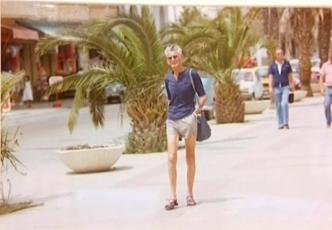What I find painful in Beckett’s Rockaby is the same phenomenon I find painful in Krapp’s Last Tape. A listener detached from the biographic plenitude of a narrative, a narrative that grows into a rhythmic exercise with no sure relation to an “I” that can encompass it and link it to the present.

The represented decisions or mental acts I witness in a production of Beckett’s late works are part of the recorded narrative that both the figure on the stage and I as audience hear.
In Rockaby it is…
the decision to stop searching the streets for another creature like herself,
the decision to stop seeking for another creature in a window in the flats opposite,
the decision to stop seeking for the evidence of another creature in those windows that would be indicated by a raised blind,
the decision to descend the stairs and sit in the rocking chair in which the mother died,
the decision to function as another creature for herself (the ostensible impetus to the construction of the third-person, self objectifying narrative itself),
and the decision to stop the narrative process, the process of “saying to herself.”
This narrative marks the movement of a woman identified as she through three locations–the streets, an upstairs room, the space occupied by a rocking chair in a downstairs room. The text to which I and the woman in the rocking chair listen brings us from the implied past of the figure to a time perhaps approximate to the present moment, but the narrative constructs this moment as a segment of the narrative itself initiated by the final imperative “More” spoken by the figure in the rocking chair. The separation of figure and recited narrative suggests that the narrative is not being formed at the moment but is, rather, a text revolving in compulsive repetition.
The convention of stage figure and recorded text here is not identical to the technique of the voice over we grown familiar with since Olivier’s film version of Hamlet. There the words of the soliloquy “To be or not to be…” appear to be forming themselves within Hamlet’s mind at that very moment in which he stares over the parapet in apparent silence.
I reduce the communicative force of Beckett’s later drama if I interpret the juxtaposition of voice and stage figure merely as a conventional dramatic monologue enhanced with the technology of recording to allow the actor to represent both the subtle inflections of speech and the signifying responses to listening.
Conventions of live performance stimulate the spectator to inscribe the narrative onto the actor/character while the text itself (and its dislocation from the figure) work both to supply the details of that narrative and to complicate or equivocate the relationship between narrative text and stage figure. It is this conflict between the mimetic impulse and its frustration that constitutes the action of Beckett’s late dramas. These works push the conventions of performance radically to the limit and provoke a mimetic reconstruction of its physical figures only to deplete that reading of character. The established emptiness prompts me to confront more fundamental problems than either existential alienation or a stoic acceptance of death. The gap between figure and narrative works towards the recognition that the narrative past is unrecoverable and unverifiable as history, memory or invention. Simultaneously, the past is inescapable as it provides the only available material for narration even as its attenuation transforms this material into traces of its ostensibly prior form as history, memory, or invention.
Confronting the process of saying leads towards the recognition of having been said. Being not merely the agent but also the product of that speech. Being a narrative subject whose presence always recedes immediately into the phenomenon of the text, with all of the complexities and indeterminacies attendant on textuality. Framing oneself in a narrative or being framed in a narrative is as much a depletion of subjectivity as it is an assertion of subjectivity.
In Beckett’s work a particular kind of speech act recurs: a speaker/writer focuses upon a textual image of a figure in space that relates to a possible visual image, a “figment”. Then, almost immediately, that figure questions the validity, reliability, or veracity of the speech/writing that posits that image. As visual image, the figure holds no real stability but appears to come and go in the mental field the text sets up. While the textual image in which the visual is represented feels more grounded, the indeterminacy or inaccuracy of language diffuses any sense that words can adequately represent it. The principal figure on stage becomes equivocal and elusive, both as a visual image subject to the difficulties of perception and as a rhetorical construct subject to the problematics of language.
As I am dealing with the concrete, material presence of the actor (a stable visual image) the narrative becomes not a sequence of read words but an acoustic presence.
I recognize that the structure formed by the performance constitutes a confinement for the firgure yet at the same time the repetition and attenuation satisfies. To respond to these performances primarily as mimetic representations of character without attending to their disturbing questioning of the status of the voice or speech and the ways in which it complicates subjectivity both trivializes and sentimentalizes important theatrical experiments. Experiments that thirty years ago represented already failed attempts to capture the present and the presence that theatre claims as its own.
